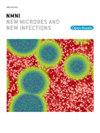Anti-TB treatment outcomes in TB meningitis: A systematic review and meta-analysis
IF 5.4
Q2 INFECTIOUS DISEASES
引用次数: 0
Abstract
Introduction
Tuberculous meningitis (TBM) remains a leading cause of mortality and neurological disability in both children and adults. This systematic review and meta-analysis aim to assess the treatment outcomes of anti-tuberculosis drugs in TBM patients, focusing on mortality and neurological disability.
Methods
We conducted a comprehensive literature search on PubMed/MEDLINE, EMBASE, and Cochrane CENTRAL databases to identify articles reporting treatment outcomes in TBM up to December 15, 2024. Studies included in the analysis reported treatment outcomes for TBM patients. Pooled analyses were performed using random-effects model to assess mortality rates, neurological disability, and loss to follow-up.
Results
A total of 10 studies involving 2005 patients were included in the analysis. The pooled all-cause mortality rate across studies was 27.7 % (95 % CI: 22.6–33.4 %, I2: 76 %), with higher mortality observed in HIV-positive individuals (40.3 %) compared to HIV-negative patients (17.1 %). The pooled rate of loss to follow-up was 6.6 % (95 % CI: 4.7–9.1 %). Subgroup analysis revealed that the mortality rate increased from 18.9 % at 3 months to 29.1 % at 6 months. The frequency of neurological disability was higher among studies using the Modified Rankin Scale (41.7 %) compared to the Barthel Index (14.1 %).
Conclusions
This study highlights the high mortality and significant neurological disability in TBM patients, particularly in HIV-positive individuals. Our findings emphasize the need for standardized outcome reporting and the incorporation of new therapeutic strategies, and improved diagnostic tools, to enhance clinical outcomes. Future research should focus on addressing these areas to optimize treatment protocols and reduce the burden of TBM.
结核性脑膜炎的抗结核治疗结果:系统回顾和荟萃分析
结核性脑膜炎(TBM)仍然是儿童和成人死亡和神经功能障碍的主要原因。本系统综述和荟萃分析旨在评估TBM患者抗结核药物的治疗效果,重点关注死亡率和神经功能障碍。方法我们对PubMed/MEDLINE、EMBASE和Cochrane CENTRAL数据库进行了全面的文献检索,以确定截至2024年12月15日报道TBM治疗结果的文章。分析中包括的研究报告了TBM患者的治疗结果。采用随机效应模型进行汇总分析,评估死亡率、神经功能障碍和随访损失。结果共纳入10项研究,涉及2005例患者。所有研究的合并全因死亡率为27.7% (95% CI: 22.6 - 33.4%, I2: 76%), hiv阳性患者的死亡率(40.3%)高于hiv阴性患者(17.1%)。随访损失的总比率为6.6% (95% CI: 4.7 - 9.1%)。亚组分析显示,死亡率从3个月时的18.9%上升到6个月时的29.1%。在使用改良Rankin量表的研究中,神经功能障碍的发生率(41.7%)高于Barthel指数(14.1%)。结论:TBM患者,特别是hiv阳性患者具有高死亡率和显著的神经功能障碍。我们的研究结果强调需要标准化的结果报告和新的治疗策略的结合,以及改进的诊断工具,以提高临床结果。未来的研究应着重解决这些问题,以优化治疗方案,减轻TBM的负担。
本文章由计算机程序翻译,如有差异,请以英文原文为准。
求助全文
约1分钟内获得全文
求助全文
来源期刊

New Microbes and New Infections
Medicine-Infectious Diseases
CiteScore
10.00
自引率
2.50%
发文量
91
审稿时长
114 days
 求助内容:
求助内容: 应助结果提醒方式:
应助结果提醒方式:


